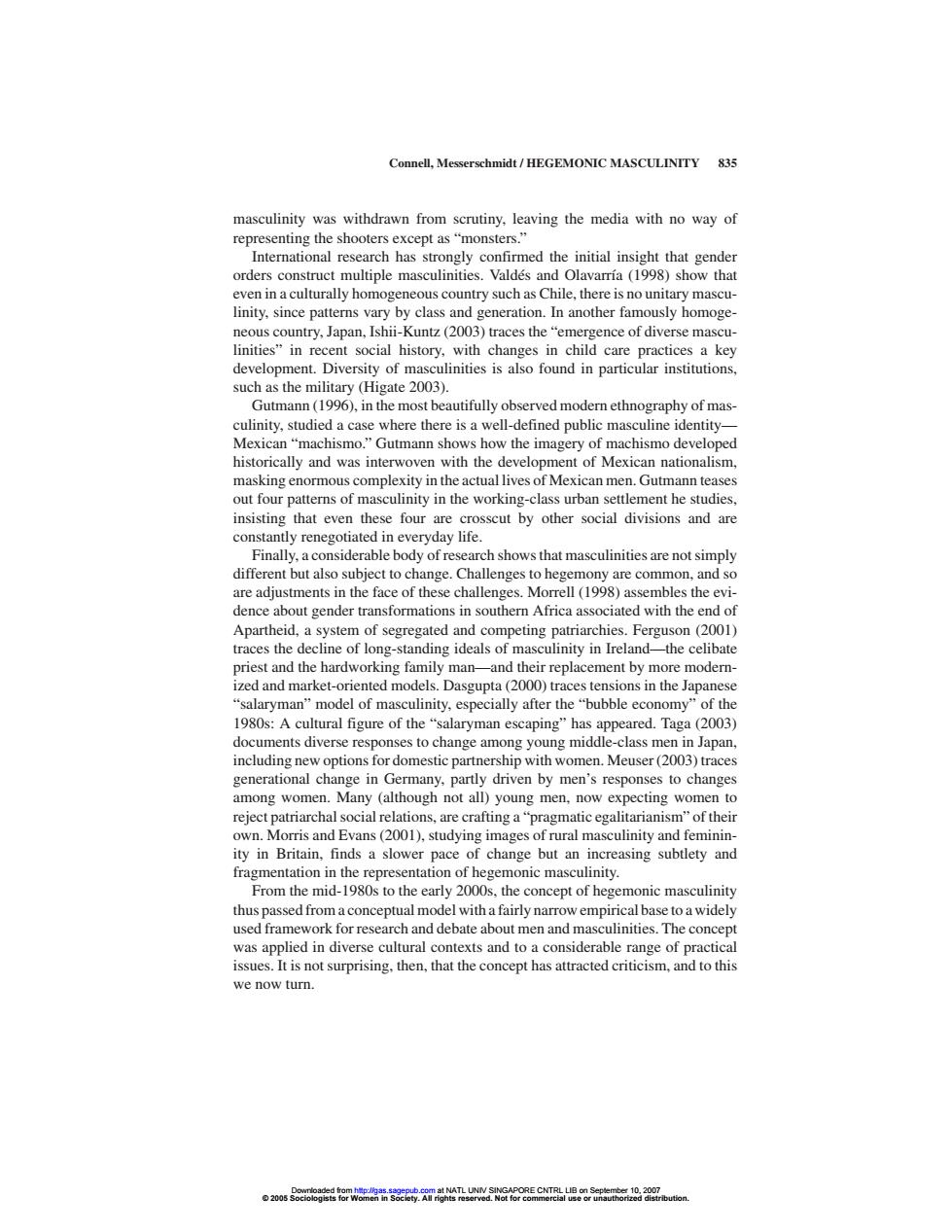正在加载图片...

Connell,Messerschmidt/HEGEMONIC MASCULINITY 835 masculinity was withdrawn from scrutiny,leaving the media with no way of representing the shooters except as"monsters." International research has strongly confirmed the initial insight that gender orders construct multiple masculinities.Valdes and Olavarria (1998)show that even in a culturally homogeneous country such as Chile,there is no unitary mascu- linity,since patterns vary by class and generation.In another famously homoge- neous country,Japan,Ishii-Kuntz(2003)traces the"emergence of diverse mascu- linities"in recent social history,with changes in child care practices a key development.Diversity of masculinities is also found in particular institutions, such as the military (Higate 2003). Gutmann(1996),in the most beautifully observed modern ethnography of mas- culinity,studied a case where there is a well-defined public masculine identity- Mexican"machismo."Gutmann shows how the imagery of machismo developed historically and was interwoven with the development of Mexican nationalism, masking enormous complexity in the actual lives of Mexican men.Gutmann teases out four patterns of masculinity in the working-class urban settlement he studies, insisting that even these four are crosscut by other social divisions and are constantly renegotiated in everyday life. Finally,a considerable body of research shows that masculinities are not simply different but also subject to change.Challenges to hegemony are common,and so are adjustments in the face of these challenges.Morrell(1998)assembles the evi- dence about gender transformations in southern Africa associated with the end of Apartheid,a system of segregated and competing patriarchies.Ferguson(2001) traces the decline of long-standing ideals of masculinity in Ireland-the celibate priest and the hardworking family man-and their replacement by more modern- ized and market-oriented models.Dasgupta(2000)traces tensions in the Japanese "salaryman"model of masculinity,especially after the"bubble economy"of the 1980s:A cultural figure of the"salaryman escaping"has appeared.Taga(2003) documents diverse responses to change among young middle-class men in Japan, including new options for domestic partnership with women.Meuser(2003)traces generational change in Germany,partly driven by men's responses to changes among women.Many (although not all)young men,now expecting women to reject patriarchal social relations,are crafting a"pragmatic egalitarianism"of their own.Morris and Evans(2001),studying images of rural masculinity and feminin- ity in Britain,finds a slower pace of change but an increasing subtlety and fragmentation in the representation of hegemonic masculinity. From the mid-1980s to the early 2000s,the concept of hegemonic masculinity thus passed from a conceptual model with a fairly narrow empirical base to a widely used framework for research and debate about men and masculinities.The concept was applied in diverse cultural contexts and to a considerable range of practical issues.It is not surprising.then,that the concept has attracted criticism.and to this we now turn. o2oosS6e08a8rmh8Pg532RT4T60N66O2EnCTBgartto1827butionmasculinity was withdrawn from scrutiny, leaving the media with no way of representing the shooters except as “monsters.” International research has strongly confirmed the initial insight that gender orders construct multiple masculinities. Valdés and Olavarría (1998) show that even in a culturally homogeneous country such as Chile, there is no unitary masculinity, since patterns vary by class and generation. In another famously homogeneous country, Japan, Ishii-Kuntz (2003) traces the “emergence of diverse masculinities” in recent social history, with changes in child care practices a key development. Diversity of masculinities is also found in particular institutions, such as the military (Higate 2003). Gutmann (1996), in the most beautifully observed modern ethnography of masculinity, studied a case where there is a well-defined public masculine identity— Mexican “machismo.” Gutmann shows how the imagery of machismo developed historically and was interwoven with the development of Mexican nationalism, masking enormous complexity in the actual lives of Mexican men. Gutmann teases out four patterns of masculinity in the working-class urban settlement he studies, insisting that even these four are crosscut by other social divisions and are constantly renegotiated in everyday life. Finally, a considerable body of research shows that masculinities are not simply different but also subject to change. Challenges to hegemony are common, and so are adjustments in the face of these challenges. Morrell (1998) assembles the evidence about gender transformations in southern Africa associated with the end of Apartheid, a system of segregated and competing patriarchies. Ferguson (2001) traces the decline of long-standing ideals of masculinity in Ireland—the celibate priest and the hardworking family man—and their replacement by more modernized and market-oriented models. Dasgupta (2000) traces tensions in the Japanese “salaryman” model of masculinity, especially after the “bubble economy” of the 1980s: A cultural figure of the “salaryman escaping” has appeared. Taga (2003) documents diverse responses to change among young middle-class men in Japan, including new options for domestic partnership with women. Meuser (2003) traces generational change in Germany, partly driven by men’s responses to changes among women. Many (although not all) young men, now expecting women to reject patriarchal social relations, are crafting a “pragmatic egalitarianism” of their own. Morris and Evans (2001), studying images of rural masculinity and femininity in Britain, finds a slower pace of change but an increasing subtlety and fragmentation in the representation of hegemonic masculinity. From the mid-1980s to the early 2000s, the concept of hegemonic masculinity thus passed from a conceptual model with a fairly narrow empirical base to a widely used framework for research and debate about men and masculinities. The concept was applied in diverse cultural contexts and to a considerable range of practical issues. It is not surprising, then, that the concept has attracted criticism, and to this we now turn. Connell, Messerschmidt / HEGEMONIC MASCULINITY 835 © 2005 Sociologists for Women in Society. All rights reserved. Not for commercial use or unauthorized distribution. Downloaded from http://gas.sagepub.com at NATL UNIV SINGAPORE CNTRL LIB on September 10, 2007